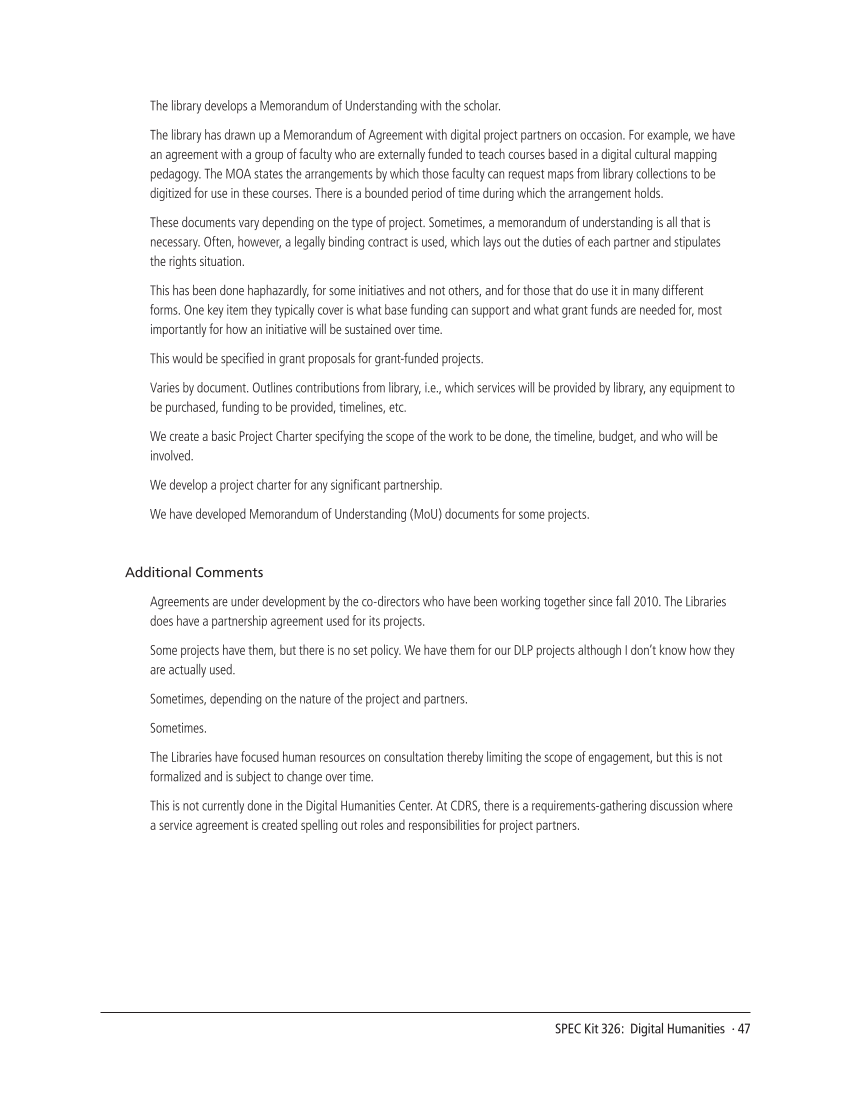SPEC Kit 326: Digital Humanities · 47
The library develops a Memorandum of Understanding with the scholar.
The library has drawn up a Memorandum of Agreement with digital project partners on occasion. For example, we have
an agreement with a group of faculty who are externally funded to teach courses based in a digital cultural mapping
pedagogy. The MOA states the arrangements by which those faculty can request maps from library collections to be
digitized for use in these courses. There is a bounded period of time during which the arrangement holds.
These documents vary depending on the type of project. Sometimes, a memorandum of understanding is all that is
necessary. Often, however, a legally binding contract is used, which lays out the duties of each partner and stipulates
the rights situation.
This has been done haphazardly, for some initiatives and not others, and for those that do use it in many different
forms. One key item they typically cover is what base funding can support and what grant funds are needed for, most
importantly for how an initiative will be sustained over time.
This would be specified in grant proposals for grant-funded projects.
Varies by document. Outlines contributions from library, i.e., which services will be provided by library, any equipment to
be purchased, funding to be provided, timelines, etc.
We create a basic Project Charter specifying the scope of the work to be done, the timeline, budget, and who will be
involved.
We develop a project charter for any significant partnership.
We have developed Memorandum of Understanding (MoU) documents for some projects.
Additional Comments
Agreements are under development by the co-directors who have been working together since fall 2010. The Libraries
does have a partnership agreement used for its projects.
Some projects have them, but there is no set policy. We have them for our DLP projects although I don’t know how they
are actually used.
Sometimes, depending on the nature of the project and partners.
Sometimes.
The Libraries have focused human resources on consultation thereby limiting the scope of engagement, but this is not
formalized and is subject to change over time.
This is not currently done in the Digital Humanities Center. At CDRS, there is a requirements-gathering discussion where
a service agreement is created spelling out roles and responsibilities for project partners.
The library develops a Memorandum of Understanding with the scholar.
The library has drawn up a Memorandum of Agreement with digital project partners on occasion. For example, we have
an agreement with a group of faculty who are externally funded to teach courses based in a digital cultural mapping
pedagogy. The MOA states the arrangements by which those faculty can request maps from library collections to be
digitized for use in these courses. There is a bounded period of time during which the arrangement holds.
These documents vary depending on the type of project. Sometimes, a memorandum of understanding is all that is
necessary. Often, however, a legally binding contract is used, which lays out the duties of each partner and stipulates
the rights situation.
This has been done haphazardly, for some initiatives and not others, and for those that do use it in many different
forms. One key item they typically cover is what base funding can support and what grant funds are needed for, most
importantly for how an initiative will be sustained over time.
This would be specified in grant proposals for grant-funded projects.
Varies by document. Outlines contributions from library, i.e., which services will be provided by library, any equipment to
be purchased, funding to be provided, timelines, etc.
We create a basic Project Charter specifying the scope of the work to be done, the timeline, budget, and who will be
involved.
We develop a project charter for any significant partnership.
We have developed Memorandum of Understanding (MoU) documents for some projects.
Additional Comments
Agreements are under development by the co-directors who have been working together since fall 2010. The Libraries
does have a partnership agreement used for its projects.
Some projects have them, but there is no set policy. We have them for our DLP projects although I don’t know how they
are actually used.
Sometimes, depending on the nature of the project and partners.
Sometimes.
The Libraries have focused human resources on consultation thereby limiting the scope of engagement, but this is not
formalized and is subject to change over time.
This is not currently done in the Digital Humanities Center. At CDRS, there is a requirements-gathering discussion where
a service agreement is created spelling out roles and responsibilities for project partners.
































































































































































































